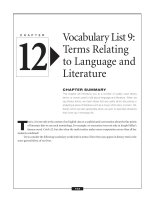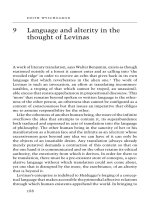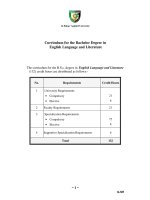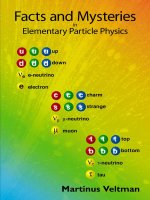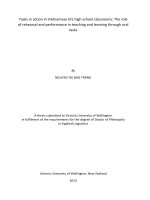Teaching language and literature in elementary classrooms
Bạn đang xem bản rút gọn của tài liệu. Xem và tải ngay bản đầy đủ của tài liệu tại đây (2 MB, 432 trang )
Teaching Language and Literature
in Elementary Classrooms
A RESOURCE BOOK FOR PROFESSIONAL DEVELOPMENT
This page intentionally left blank
Teaching Language and Literature
in Elementary Classrooms
A RESOURCE BOOK FOR PROFESSIONAL DEVELOPMENT
Second Edition
Marcia S. Popp
2005
LAWRENCE ERLBAUM ASSOCIATES, PUBLISHERS
Mahwah, New Jersey
London
This edition published in the Taylor & Francis e-Library, 2008.
“To purchase your own copy of this or any of Taylor & Francis or Routledge’s
collection of thousands of eBooks please go to www.eBookstore.tandf.co.uk.”
Senior Acquisitions Editor:
Assistant Editor:
Cover Design:
Textbook Production Manager:
Full-Service Compositor:
Text and Cover Printer:
Naomi Silverman
Erica Kica
Kathryn Houghtaling Lacey
Paul Smolenski
TechBooks
Hamilton Printing Company
Copyright C 2005 by Lawrence Erlbaum Associates, Inc.
All rights reserved. No part of this book may be reproduced in
any form, by photostat, microform, retrieval system, or any
other means, without prior written permission of the publisher.
Lawrence Erlbaum Associates, Inc., Publishers
10 Industrial Avenue
Mahwah, New Jersey 07430
www.erlbaum.com
Library of Congress Cataloging-in-Publication Data
Popp, Marcia S.
Teaching language and literature in elementary classrooms : a resource
book for professional development / Marcia S. Popp.—2nd ed.
p. cm.
Includes bibliographical references and index.
ISBN 0-8058-5295-6 (pbk.)
1. Language arts (Elementary) 2. Literature—Study and teaching (Elementary)
I. Title.
LB1576.P656 2006
372.6 044—dc22
2005012311
ISBN 1-4106-1388-7 Master e-book ISBN
For all the teachers in my life:
Thank you for a lifetime of inspiration and learning.
And for my husband:
The conversation continues.
This page intentionally left blank
Contents
Preface
xvii
Acknowledgments
xxiii
CHAPTER ONE
Language and Literature in Three Classrooms
1
In This Chapter
The Main Idea
In the Classroom: Three Teachers’ Views
A Kindergarten Classroom: Gail Nave, Summerfield Grade
School, Summerfield, Illinois
2
A Third-Grade Classroom: Dr. Dick Koblitz, Ralph Captain
School, Clayton, Missouri
11
A Fifth-Grade Classroom: Jackie Hogue, Marine School,
Marine, Illinois
24
What Research Has to Say About Integrating Language and
Content Area Learning
Try Out the Chapter Ideas
CHAPTER TWO
Reading Aloud: Literacy Begins With Listening
In This Chapter
The Main Idea
In the Classroom
A Kindergarten Classroom
39
A Primary Classroom
42
An Intermediate Classroom
43
The Importance of Reading Aloud
Preparing to Read Aloud in the Classroom
Determine the Purpose for Reading Aloud
46
Consider the Experience and Interests of Your Audience
Assess the Resources for Reading Aloud
48
1
1
1
36
37
39
39
39
39
45
46
47
vii
viii
Contents
Presentation—Reading a Book Aloud
Evaluating the Read-Aloud Experience
Build Partnerships
If This Is Your Situation
Reflections (Charles Kamm, Retired Teacher and Principal)
A Perspective on Reading Aloud (Jim Trelease, Author)
What Research Says About the Benefits of
Reading Aloud
For Your Personal Library
Humor for All Occasions
55
Stories of the World
55
Try Out the Chapter Ideas
CHAPTER THREE
Independent Reading: Exploring on Their Own
In This Chapter
The Main Idea
In the Classroom
A Kindergarten Classroom: Silent Sustained Reading
A Primary Classroom: Reviewing Strategies
58
An Intermediate Classroom: Discovering New Books
The Importance of Independent Reading Practice
Preparation: Independent Reading in the Classroom
Introduce the Idea of Independent Reading
64
Create a Comfortable Reading Environment
65
Select a Wide Range of Reading Materials
65
Teach Independent Reading Strategies
66
Model Self-Selection Techniques
66
Use Various Ways to Preview Good Books
67
Don’t Judge a Book by Its Cover
69
Presentation: Manage Independent Reading Time
Evaluating Your Independent Reading Program
Build Partnerships
If This Is Your Situation
Reflections (Jackie Hogue, Fifth-Grade Teacher)
A Perspective on Independent Reading (John Dewey,
Philosopher of Education)
What Research Says About Independent Reading
For Your Personal Library
Try Out the Chapter Ideas
48
50
51
52
53
53
54
55
56
57
57
57
57
57
60
62
63
69
70
71
71
72
72
73
75
75
Contents
ix
CHAPTER FOUR
Creating a Literature Base
77
In This Chapter
The Main Idea
In the Classroom
Pre-Teaching Preparation: The Textbook as Future
Reference
77
Student Teaching: Gaining Experience With Books
80
First-Year Teaching: Using Book Clubs
82
The Importance of Creating a Literature Base for Instruction
Preparing a Literature Base
Kinds of Children’s Literature and Examples
85
Presentation: Using the Literature Base for Instruction
Evaluating Children’s Literature: How to Choose the Best
Creating an Award-Winning Library
93
Using School Book Clubs Effectively
94
Series Books
95
Series With Substance
98
Helping Students Develop Book Selection Skills
101
Build Partnerships
If This Is Your Situation
Reflections (Gail Nave, Kindergarten Teacher)
A Perspective on School Reading (John Dewey, Philosopher
of Education)
What Research Says About Selecting High-Quality Literature
For Your Personal Library
Try Out the Chapter Ideas
CHAPTER FIVE
Guided Reading
77
77
77
83
84
91
93
101
102
103
103
104
104
105
107
In This Chapter
The Main Idea
In the Classroom
A Kindergarten Classroom—Whole Class Instruction:
Big Book
107
A Primary Classroom—Literature Groups: Single Title
An Intermediate Classroom—Literature Groups:
Multiple Titles
115
The Importance of Guided Reading
Preparation: Guided Reading
107
107
107
111
119
120
x
Contents
Presentation: A Guided Reading Session
A Kindergarten Classroom—Guided Reading With
a Big Book
123
A Primary Classroom—Introducing Literature Response
Questions
124
An Intermediate Classroom—Discussion Groups
124
Evaluating Progress in Guided Reading
Build Partnerships
If This Is Your Situation
Basal Texts—Levels of Involvement
128
Reflections—Pat Sheahan (Second-Grade Teacher)
A Perspective on Guided Reading (Louise Rosenblatt,
Language Theorist)
What Research Says About Guided Reading
For Your Personal Library
Try Out the Chapter Ideas
122
126
127
127
129
130
131
132
133
CHAPTER SIX
Mini-Lessons
135
In This Chapter
The Main Idea
In the Classroom
A Kindergarten Classroom: Small-Group Skill Practice
A Primary Class: Using Literature to Develop Concepts
An Intermediate Classroom: Connecting Reading and
Writing
142
The Importance of Mini-Lessons
Preparing for Mini-Lessons
Presentation: Mini-Lessons
Academic Skills
148
Social Interactive Skills
148
Caretaking Skills
148
Creative Skills
149
Evaluating Mini-Lessons
Build Partnerships
If This Is Your Situation
Reflections (Jackie Hogue, Fifth-Grade Teacher)
A Perspective on Mini-Lessons (Jerome Bruner,
Educational Theorist)
What Research Says About Mini-Lessons
For Your Personal Library
Try Out the Chapter Ideas
135
135
135
135
138
144
146
147
149
150
150
151
151
152
152
153
Contents
xi
CHAPTER SEVEN
Individual Reading Conferences
In This Chapter
The Main Idea
In the Classroom
A Kindergarten Classroom: The Emerging Reader
155
An Early Primary Classroom: Assessing Competence
160
A Primary Classroom: Sharing Ideas and Developing
Skills
163
An Intermediate Classroom: Encouraging Exploration and
Reflection
166
The Importance of Individual Reading Conferences
Preparing for Individual Reading Conferences
Prepare the Entire Class
173
Help Individual Students Get Ready
175
Presentation: The Individual Reading Conference
Begin the Conversation
176
Ending the Session
177
Summarize
177
Show Personal Interest
177
Make Assignments
178
Help Everyone Participate
178
Evaluating the Individual Reading Conference
Build Partnerships
If This Is Your Situation
Reflections (Patricia Sheahan, Second-Grade Teacher)
A Perspective on Individual Reading Conferences
(Lev Vygotsky, Language Theorist)
What Research Says About Individual Reading Conferences
For Your Personal Library
Try Out the Chapter Ideas
CHAPTER EIGHT
Writing to Create Meaning
In This Chapter
The Main Idea
In the Classroom
A Kindergarten Classroom: Captions
185
A Kindergarten Classroom: Key Words
187
A Kindergarten Classroom: Language Experience Charts
191
A Kindergarten Classroom: Shared Writing
194
A Primary Classroom: Word Charts, Poems, Journals
196
155
155
155
155
171
173
175
179
180
181
181
182
182
183
184
185
185
185
185
xii
Contents
A Primary Classroom: An Individual Writing Conference
197
An Early Intermediate Classroom: Mini-Lessons and
Writer’s Workshop
200
A Late Intermediate Classroom: The Author’s Chair
203
The Importance of Writing
Preparing for Writing Activities
Materials
206
Plan for Everyone to Participate
208
Presentation: Writing Activities
Key Words
210
Captions
211
Language Experience Charts
211
Chart Lists
213
Spelling
214
Handwriting
214
Skills Notebooks
215
Writer’s Workshop
216
Individual Writing Conferences
217
Evaluating Writing Development
Portfolios
220
Two-Minute Conferences
221
Build Partnerships
If This Is Your Situation
Reflections (Julia Parker, Fourth-Grade Teacher)
A Perspective on Writing (Sylvia Ashton-Warner,
Teacher/Author)
What Research Says About Writing
For Your Personal Library
Try Out the Chapter Ideas
CHAPTER NINE
Listening and Speaking
In This Chapter
The Main Idea
In the Classroom
A Kindergarten Classroom: Using Words in Social
Situations
229
A Primary Classroom: Friday Afternoon Sharing Time
235
An Intermediate Classroom: A Shared-Pair Discussion
239
The Importance of Developing Listening and Speaking Skills
Preparing for Listening and Speaking Activities
Oral Reading
244
Book Previews
245
205
206
210
219
221
222
223
224
225
226
227
229
229
229
229
242
244
Contents
xiii
Examples of Grade-Level Previews
246
Shared-Pair Discussions
248
Creative Drama
249
Reader’s Theater
251
Puppet Theater
251
Friday Afternoon Sharing Time (FAST)
253
Audience Preparation
256
Presentation: Friday Afternoon Sharing Time
Evaluating Speaking and Listening Activities
Health and Safety Presentations
258
Provide for All Speakers and Listeners
259
Build Partnerships
If This Is Your Situation
Reflections (Jackie Hogue, Fifth-Grade Teacher)
Perspective on Listening and Speaking (Jerome Bruner,
Educational Theorist)
What Research Says About Developing Listening and
Speaking Skills
For Your Personal Library
Try Out the Chapter Ideas
CHAPTER TEN
The Languages of Learning in the Content Areas
In This Chapter
The Main Idea
In the Classroom
A Kindergarten Classroom: Exploring Mathematics
With Language
268
A Kindergarten Classroom: Exploring Science With
Literature
270
A Primary Classroom: Science, Computers, Language,
and Literature
272
A Primary Classroom: Exploring Social Studies
With Language
275
An Intermediate Classroom: Social Studies and
Theme Cycles
277
An Intermediate Classroom: Social Studies Sociodrama
282
The Importance of Themes and the Languages of Learning
Themes: Organizing Ideas and Creating Connections
Theme Units
285
Theme Topics
287
Theme Cycles
289
Preparing for Theme Activities
Creating a Theme Cycle
290
257
258
260
261
262
263
264
264
265
267
267
267
268
284
285
290
xiv
Contents
Considering All Learners
291
Presentation: Using Language to Explore Ideas and Information
The Theme Cycle
293
Recording and Responding to Ideas and Information:
Learning Journals
295
Student Activities to Explore and Explain Ideas
298
Teacher-Directed Experiences to Assist Learning
Evaluating Learning in the Content Areas
Build Partnerships
If This Is Your Situation
Reflections (Christine Lanning, Fifth-Grade Teacher)
A Perspective (Eleanor Duckworth, Teacher/Researcher)
What Research Says About Literature in the Content Areas
For Your Personal Library
Try Out the Chapter Ideas
CHAPTER ELEVEN
The Languages of Expression—Play, Media, and the Fine Arts
In This Chapter
The Main Idea
In the Classroom
A Kindergarten Classroom: Play, Drama, and Literacy
309
A Kindergarten Classroom: Drama and Music
312
The Importance of Play and the Fine Arts in Emerging Literacy
Preparing for Play and Fine Arts Activities
Presentation: Introduction to Play Centers
A Primary Classroom: Movies and Literacy
316
The Importance of Media and Literacy
Preparing for a Media-Literacy Experience
Presentation: A Movie and Discussion
An Intermediate Classroom: Art History
320
Importance of Expression Through the Arts
Literature for the Arts
324
Presentation: Exercises to Express Responses to the Fine Arts
Respond to Art
325
Respond to Music
326
Exploring Art in Reverse: What Do You Hear?
326
Exploring Music in Reverse: What Do You See?
327
What Can’t You See in a Painting?
328
Begin with a Line . . .
329
Evaluating Play and Artistic Experiences
293
299
301
302
303
304
305
306
307
307
309
309
309
309
314
314
315
318
319
319
323
325
330
Contents
xv
Build Partnerships
If This Is Your Situation
Reflections (The Author)
A Perspective (Karen Gallas, Teacher/Researcher)
What Research Has to Say About Play, Language, and Literature
For Your Personal Library
Try Out the Chapter Ideas
APPENDIX A
Minimizing Distractions to Learning
Anticipate Responses
Adjust Expectations
Analyze Causes of Disruption
Normal Disruptions
Twenty Quick Ways to Deal With Impulsive Behaviors: How to
Save Your Sanity and Get on With the Day
Other Causes of Misbehavior
APPENDIX B
Book Selection Literature
Book Links: Connecting Books, Libraries, and Classrooms
The Horn Book Magazine
Multicultural Publishers Exchange Catalog of Books by and
About People of Color
Notable Children’s Trade Books in Social Studies
Outstanding Science Trade Books for Children
American Library Association Notable Children’s Books
Children’s Choices Awards
Other Sources of Reviews
APPENDIX C
Awards for Children’s Literature
United States
Canada
United Kingdom
Australia
New Zealand
International
330
331
332
333
334
335
336
337
337
338
338
339
340
345
346
346
346
347
347
347
348
348
348
350
350
352
352
353
353
353
xvi
Contents
APPENDIX D
Student Forms and Guidelines
Identify the Genre—Primary
Identify the Genre—Intermediate
Special Features of Informational Books
Types of Literature: A Genre Checklist—Intermediate
Student Reading Conference Preparation: Primary
Student Conference Preparation: Intermediate
Student Preconference Memo to Teacher
Guidelines for Biographical Writing: Primary and Intermediate
Oral Reading Exercises
List of Book Response Activities for FAST
FAST Proposal
FAST Presentation Review Form
FAST Presentation Record
APPENDIX E
Teacher Forms and Guidelines
Personal Response to Literature
Comprehension
Mechanics
Sense of Audience
Sample Skills Checklist for Kindergarten
Sample Skills Checklist for Kindergarten/
Early Primary/Developmental
Sample Skills Checklist for Late Primary/Intermediate
Identifying the Genre: Kindergarten
Writing Conference Form
Sample Questions for Writing Conference
Additional Follow-up Questions
Writing Skills Checklist: Primary/Intermediate
354
354
355
356
356
357
357
358
358
358
359
360
361
361
362
362
362
363
363
364
364
365
366
366
366
367
367
References
369
Author Index
383
Subject Index
389
Preface
New to This Edition
This revised edition of Teaching Language and Literature in Elementary Classrooms: A Resource Book for Professional Development retains the purposes of
the first edition, but adds ideas and information gathered over the years
from new classroom observations. It also incorporates the results of extensive reviews of educational research, continuous reading in all the genres
of children’s literature, and correspondence with faculty and students. In
response to these varied and helpful experiences, the following elements
will be found in this second edition:
• Strategies for dealing with problems of disruption in the classroom
• Expanded discussions related to diversity and special needs
• Increased attention to methods of evaluation and mandated testing
programs
• Reorganization of chapter sections to make them more useful to
readers
• A new chapter on Play and the Fine Arts
• Integration of electronic teaching technology into all chapters
• Extensive in-text annotations of children’s literature, discussions of
new titles in children’s literature, cultural literatures, book clubs,
series books, and the influence of books published internationally
• Updated reports of research and best-practice studies
• New classroom observations
Also new to this edition is a set of appendixes designed to provide information and resources for instructional support. They include:
Appendix A: Minimizing Distractions to Learning—Preventing and responding to classroom disruptions; information and ideas drawn from the
author’s experiences in special education and the literature of educational
psychology
Appendix B: Book Selection Literature—Annotations of key reference
works helpful for book selection and instruction
Appendix C: Awards for Children’s Literature—Books honored in the
United States, Canada, the United Kingdom, Australia, and New Zealand
Appendix D: Student Forms and Guidelines—Sample guidelines for
responding to reading; preparing for conferences; and evaluating writing,
listening, and speaking
xvii
xviii
Preface
Appendix E: Teacher Forms and Guidelines—Sample guidelines for
conference preparation and evaluation of learning
The Continuing Purpose of This Text
In light of the changes to the text described above, it is important to note
those aspects that have remained the same. The original edition of Teaching
Language and Literature in Elementary Classrooms was written for two major
purposes:
• The first was to provide beginning educators with a handbook on
language arts instruction that would serve both as a text and a professional resource to be carried into the first year of teaching. Nearly
a decade after its initial publication, this text remains the only one
in the field designed specifically for this purpose.
• The second purpose of the original text was to share the talents
and enthusiasm of the many competent teachers I had observed in
elementary classrooms over a period of 30 years in the field. Some
were my colleagues when I was an elementary school teacher, and
others were visited regularly as part of my work to place teachersin-training with classroom mentors. I watched these exceptional
educators at work—listened, asked questions, and recorded what I
learned. As a professor of education, I tried to share as much as
possible from these observations with my undergraduate students.
This revised text, as did the first edition, represents an effort to
share these experiences with a wider audience.
Organization of the Text
The sections in each chapter of the text are arranged in an order that
helps readers move from a direct experience of the narrative to step-bystep descriptions they can follow to implement these activities in their own
classrooms. Chapter 1 presents readers with narrative accounts of entire
school days, as observed in the classrooms of three exemplary educators.
Following the observations, these teachers describe their practice in their
own words. Readers observe, firsthand, how to plan daily schedules to meet
yearly goals and provide instruction that generates excitement for learning.
Chapters 2 through 11 describe the individual practices of literaturebased, integrated language arts teaching. These include the following:
• Reading Aloud—daily sessions with teachers, book buddies, and
guest readers
• Independent Reading—the silent sustained reading of individually
chosen books
Preface
xix
• Creating a Literature Base—developing a classroom library that
supports learning in all the curriculum areas
• Guided Reading—instruction in small and large groups; literature
circles
• Mini-Lessons—brief presentations of specific skills or information
• Individual Reading Conferences—private discussions of books with
the teacher
• Writing to Create Meaning—ways to use writing as a tool for inquiry
and expression
• Listening and Speaking—developing skills that assist comprehension and expression
• The Languages of Learning in the Content Areas—using specialized languages in context, to explore ideas in mathematics, science,
and social studies
• The Languages of Expression (Play, Media, the Fine Arts)—using
play and the arts to develop language and express ideas
Individual sections are consistent from chapter to chapter throughout
the text and follow the sequence listed below:
• In This Chapter—the major topics of discussion
• The Main Idea—a brief summary of the practice to be described in
the chapter
• In the Classroom—narratives drawn from observations at all elementary instructional levels
• The Importance of the Practice—explains why a particular practice
is considered “best” practice
• Preparing for the Practice—describes how to get ready to use the
various activities that comprise literature-based, integrated language
arts teaching
• Presentation of the Practice—step-by-step suggestions for what to
say and do as activities are introduced to a class
• Evaluating the Teaching Experience—suggestions on how to measure learning and redirect teaching
• Build Partnerships—ideas for reaching out to all constituencies of
the school and community, to extend and enrich student learning
experiences
• If This Is Your Situation—ways to meet challenges such as mandated testing, required curriculum texts, and philosophical differences with colleagues, parents, or administrators
• Reflections on Practice—first-person accounts of experiences educators have had with a particular practice of language arts teaching
• Perspective—a section that features ideas from noted educators
related to the chapter practice
• What Research Says About This Practice—a brief review of studies
related to the effectiveness of the particular practice
• For Your Personal Library—an annotated list of handbooks, guides,
read-aloud books, and professional journals that can be used for
reference and resource
xx
Preface
• Try Out the Chapter Ideas—suggestions to explore the information
and observations from the chapter
Integrating Instruction
Although the individual practices of integrated language arts instruction are
discussed in separate chapters in this text, you will notice in the narratives
that they are woven throughout the curriculum and never stand alone as
context-free objects of study. For example, a mini-lesson on alliteration
may involve a particularly good read-aloud picture book. Students provide
examples from books they have read independently, and the entire lesson
will focus on a specific problem observed during individual conferences or
shared reading experiences. Practice for the skill may draw from a current
unit in science or social studies, and the lesson and examples become a
writing exercise that can later be used as reference for further learning.
In a similar vein, the first edition of this book featured a separate section devoted to the accommodation of instruction for students with special
learning needs. In the current edition, this information has been integrated
throughout each chapter—in the narratives and sections on preparation,
presentation, and evaluation. A comprehensive plan for teaching must include the consideration of every student’s abilities and challenges. All children are individuals, who bring varied experiences and skills to any learning situation. The focus is therefore on ability, not disability—building on
strengths and supporting special needs where they exist.
Special Features of This Text
The narratives in this text, and the accompanying instructions for preparing
to teach, are included for every elementary instructional level. There are
several reasons for this. First, all learning is developmental. No two children
learn at the same rate or in the same way. Every person’s experience with
language has differed from the time they were born, depending on their
physical and emotional development, their natural abilities, the use of language and books in their homes, opportunities they have had to explore the
larger world, and individual interests.
These variables continue to influence the rate at which children benefit from their experiences in the classroom, the level of their curiosity, and their desire to learn. Whether a person is assigned to teach a
self-contained kindergarten class or departmental sixth-grade language arts
in middle school, their students will be developing learners. Knowing that
language skills develop at individual rates, depending on natural ability
and environmental circumstances, beginning teachers will be in a better
position to evaluate and assist every student in their classroom.
Preface
xxi
The second reason that narratives and preparation guidelines are included for every elementary instructional level is quite practical. This book
is intended to help new teachers learn how to teach the language arts, but
it is also designed to be a reference—a resource book for professional development. From methods classes and experiences in cooperating schools,
students develop many ideas about what they want to do in their own
classrooms. The sections of this book that deal with situational challenges,
developing curriculum themes, working with classroom management problems, and creating a community of partners will assume more importance
as they move into full-time teaching.
In addition, most beginning teachers have a distinct preference for the
age of students with whom they most enjoy working. Throughout their
teaching careers, however, it is more than likely that they will be assigned
to several different grade levels. If they have observed what goes on in classrooms at all stages of elementary instruction, they will be more comfortable
and confident with these inevitable changes of assignment.
Finally, it is by conscious decision that the numberless distractions that
attend all teaching are not fully described in the classroom stories. It is
difficult enough to identify what a teacher is attempting to do in an instructional way, without adding these to the mix. In most cases, many of
the problems that detract from classroom instruction have been factored
into the ways the lessons are conducted. In addition, most of the teachers
featured in the narratives help students practice responses to disruptions in
advance, as thoroughly as they rehearse for fire drills.
But there are still days that challenge even the most effective classroom
management programs. For these times, and for other more serious difficulties with individual behavior problems, Appendix A of this book provides
suggestions for anticipating and preventing minor and major disruptions.
It presents ideas drawn from the literatures of special education and educational psychology, which have proven to be successful in a wide range of
classrooms, at all instructional levels.
It is my hope that this new edition of Teaching Language and Literature in
Elementary Classrooms will be useful to readers, not only as a textbook,
but also as a resource for instruction. Please feel free to contact me at
if there are any questions and comments about the text.
I would be most happy to hear from you.
The teaching of language arts can be both challenging and exciting. It
draws upon the most creative of our impulses and prompts us to share our
love of literature, words, and ideas with children. There can be no finer
calling than to help students develop their individual powers of learning
as they use language and literature to explore an increasingly complex and
fascinating world.
—Marcia Popp
This page intentionally left blank
Acknowledgments
I would like to thank all of the exceptional teachers who are profiled in this
book. It has been an honor to be welcomed into their classrooms, some of
which I have been visiting for more than 20 years. I am especially grateful
for the contributions of Gail Nave, Julia Parker, Christine Cook, Christine
Lanning, Ingrid Patterson, Charles Kamm, Jim Furtkamp, Rebecca Culler,
Jackie Hogue, Dick Koblitz, Kathy Burch, Cathy Woods, and many talented
but modest educators who prefer to remain anonymous. I would also like to
thank Martha Eggers, a colleague at McKendree College, whose insights,
teaching skill, and tireless efforts on behalf of her students have always been
an inspiration.
I acknowledge, with the greatest respect, Stephen Poweska, Judith Swanson, Patricia Sheahan, and Deb Cryder (all deceased), whose influence on
their colleagues and students live on in the narratives of this book.
My deepest appreciation is extended to the reviewers of this text. I would
like to thank them for their astute analyses and ideas about what could be
helpfully added to this revised edition.
I would also like to thank my extraordinary editor at Erlbaum, Naomi
Silverman, for her advice, counsel, patience and direction, and Erica Kica,
who has diligently provided the information necessary to complete this
project.
Last, but certainly not least, I would like to acknowledge Theresa Raglin,
whose encouragement, keen observations, and eye for detail were invaluable
assets in this revision.
xxiii
This page intentionally left blank
